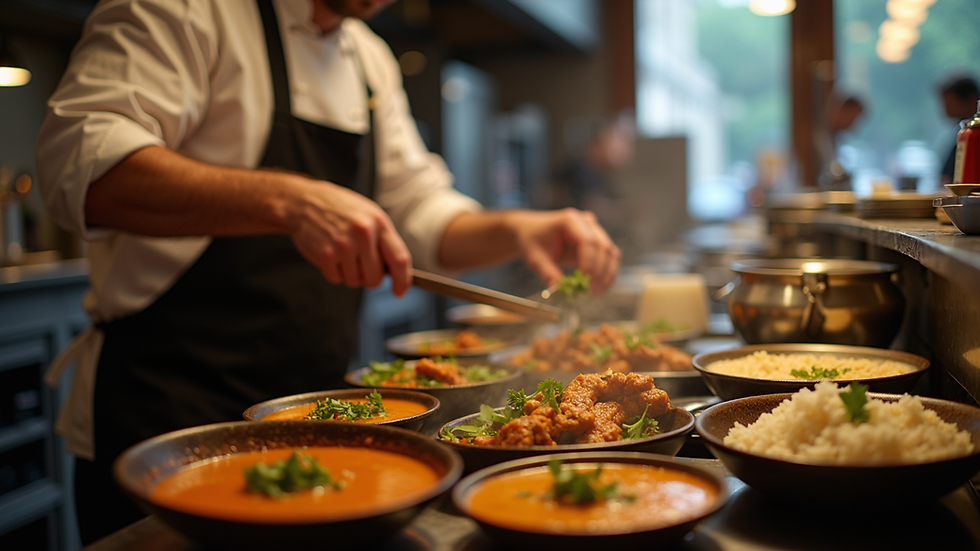What Makes Indian Restaurants Stand Out in Local Communities
- Now Tec

- Sep 11
- 4 min read
Indian restaurants have become a beloved part of many local communities around the world. Their unique blend of flavours, vibrant culture, and warm hospitality create an experience that goes beyond just dining. But what exactly makes Indian restaurants stand out in these communities? This article explores the key factors that contribute to their popularity and lasting appeal.
The Richness of Indian Cuisine in Local Restaurants
One of the most compelling reasons Indian restaurants stand out is the richness and diversity of their cuisine. Indian food is known for its complex layers of spices and herbs, which create bold and memorable flavours. Each dish tells a story of regional traditions and centuries-old recipes.
Indian restaurants often offer a wide variety of dishes, from creamy butter chicken and spicy vindaloo to vegetarian delights like paneer tikka and dal makhani. This variety caters to different tastes and dietary preferences, making Indian cuisine accessible to many.
Use of fresh spices: Indian chefs use fresh spices like cumin, coriander, turmeric, and cardamom, which enhance the aroma and taste.
Balancing flavours: The cuisine balances sweet, sour, salty, bitter, and spicy elements, creating a harmonious dining experience.
Vegetarian and vegan options: Many Indian dishes are naturally vegetarian or vegan, appealing to health-conscious diners.
This culinary richness invites locals to explore new tastes and enjoy authentic meals that are both comforting and exciting.

The Cultural Experience Indian Restaurants Bring to Communities
Indian restaurants are not just about food; they offer a cultural experience that enriches local communities. The décor, music, and hospitality reflect Indian traditions and create a welcoming atmosphere.
Many Indian restaurants decorate their spaces with vibrant colours, traditional artwork, and handcrafted items. This visual appeal transports diners to a different world, making the meal more than just about eating.
Hospitality is another key element. Indian culture places great importance on treating guests with respect and warmth. This is evident in the attentive service and friendly interactions that diners often experience.
Festivals and events: Some restaurants celebrate Indian festivals like Diwali or Holi, inviting the community to join in the festivities.
Cultural education: Menus often include explanations of dishes and their origins, helping diners learn about Indian culture.
Music and ambiance: Traditional Indian music or Bollywood tunes enhance the dining atmosphere.
This cultural immersion helps Indian restaurants become community hubs where people gather to enjoy food and learn about a rich heritage.

How Indian Restaurants Build Community Connections
Indian restaurants often play an active role in their local communities, which helps them stand out and build loyal customer bases. They engage with locals through various initiatives and partnerships.
For example, many Indian restaurants support local charities or participate in food festivals. They may also collaborate with other businesses to promote cultural exchange and community spirit.
Offering cooking classes or tasting events is another way Indian restaurants connect with their community. These activities invite people to learn about Indian cuisine hands-on, fostering appreciation and loyalty.
One notable example is masala boss wimborne minster, a restaurant that has become a beloved part of its local area by combining authentic food with community engagement.
Supporting local suppliers: Using locally sourced ingredients strengthens ties with the community.
Hosting community events: Celebrations and themed nights bring people together.
Inclusive menus: Catering to diverse dietary needs ensures everyone feels welcome.
These efforts create a sense of belonging and make Indian restaurants more than just places to eat.

The Role of Authenticity and Innovation in Indian Dining
Indian restaurants stand out by balancing authenticity with innovation. While many diners seek traditional recipes, others appreciate creative twists that keep the cuisine fresh and exciting.
Authenticity is maintained through the use of traditional cooking methods, spices, and recipes passed down through generations. This commitment to genuine flavours builds trust and respect among customers.
At the same time, innovation allows Indian restaurants to adapt to modern tastes and dietary trends. For example, some restaurants offer gluten-free naan or fusion dishes that blend Indian spices with other cuisines.
Menu variety: Offering both classic and contemporary dishes appeals to a wider audience.
Presentation: Modern plating techniques enhance the visual appeal of traditional foods.
Health-conscious options: Incorporating organic ingredients and lighter cooking methods meets current health trends.
This blend of old and new keeps Indian restaurants relevant and exciting in local dining scenes.
Why Indian Restaurants Are a Staple in Local Communities
Indian restaurants have become staples in many local communities because they offer more than just food. They provide a place for cultural exchange, social connection, and culinary adventure.
Their ability to cater to diverse tastes and dietary needs makes them inclusive and welcoming. The warm hospitality and vibrant atmosphere create memorable experiences that keep customers coming back.
Moreover, Indian restaurants often contribute positively to their communities through events, partnerships, and support for local causes. This community involvement strengthens bonds and fosters loyalty.
For those looking to explore authentic Indian cuisine in a friendly setting, visiting places like masala boss wimborne minster offers a perfect example of how Indian restaurants enrich local life.

Indian restaurants continue to thrive because they combine rich culinary traditions with community spirit and innovation. Their unique qualities make them cherished parts of local dining landscapes.





Comments